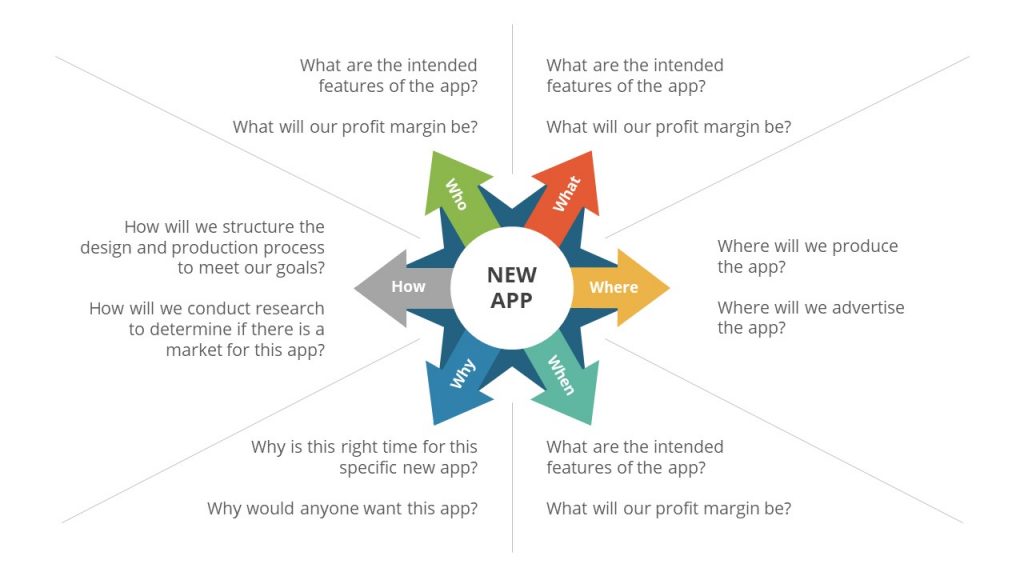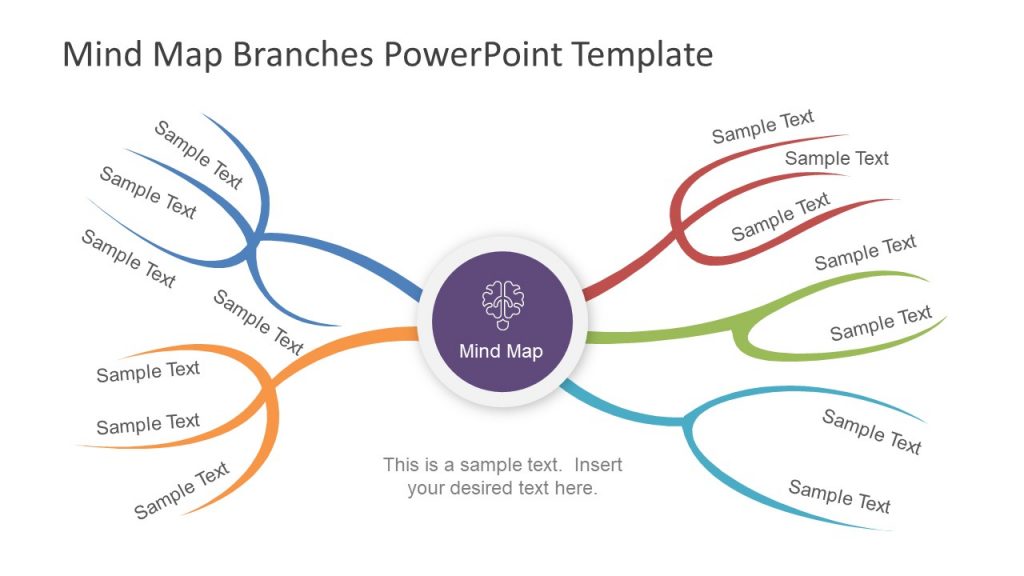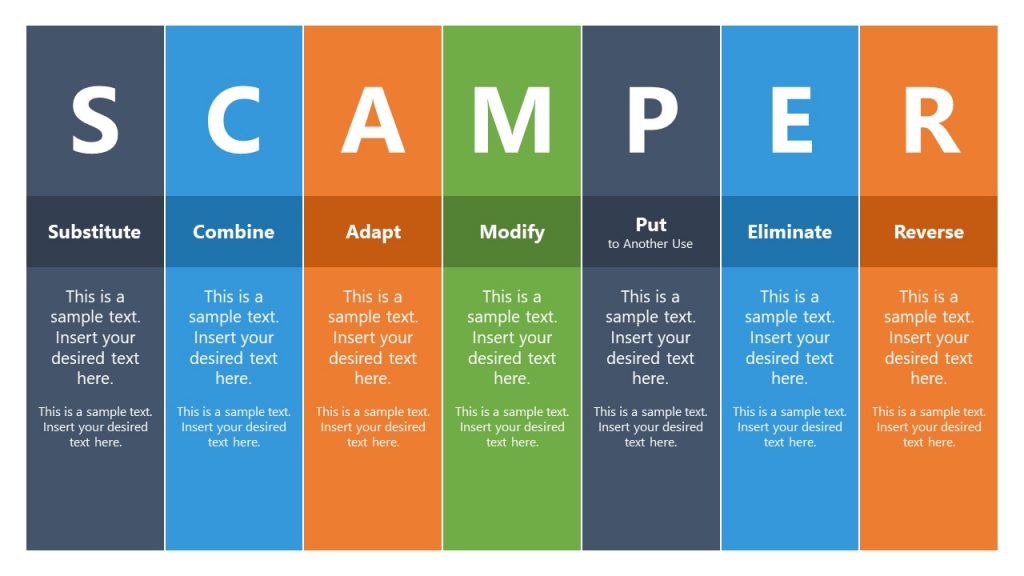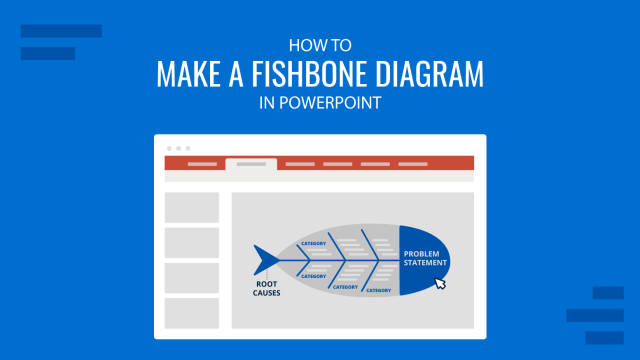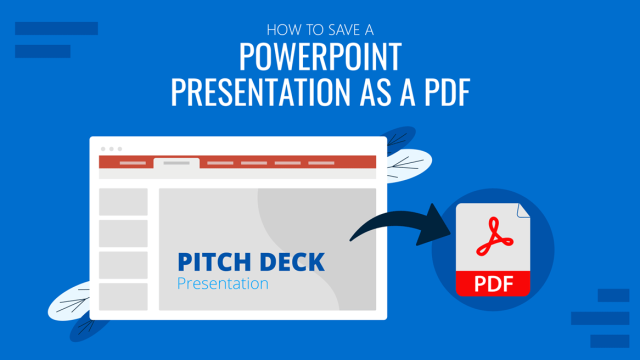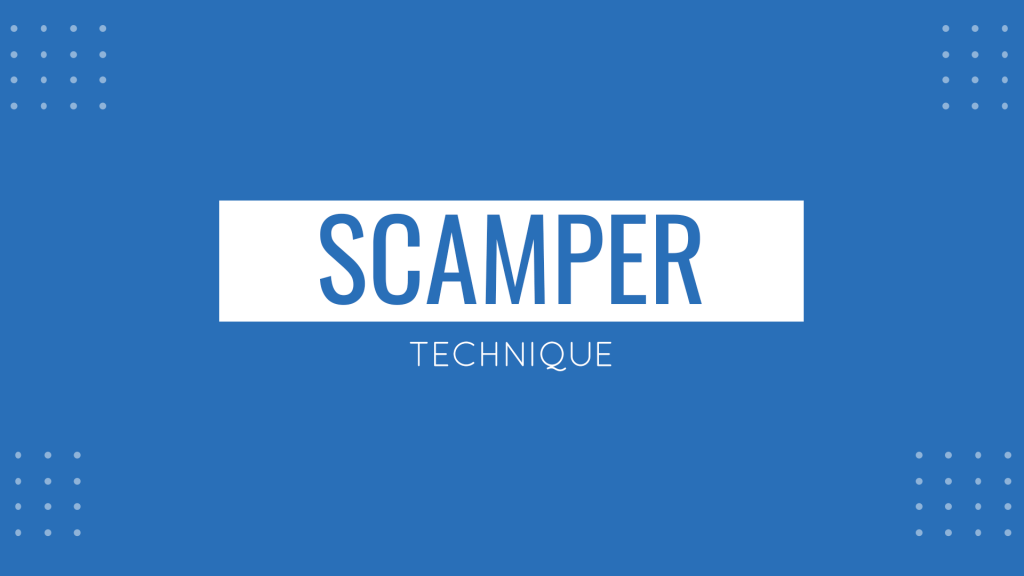
When looking for solutions or generating ideas, sometimes the answers to complex questions can be found in substitution, adaptation, or realignment. SCAMPER is a technique that provides a structured approach towards thinking outside the box to explore new concepts, solutions and to enhance learning.
Table of Contents
- What is SCAMPER?
- How to Use the SCAMPER Ideation Method?
- Using the SCAMPER Technique as a Presenter During an Interactive Presentation
- Best Practices for SCAMPER Sessions
- How to Present your SCAMPER Session Results
- Alternatives to SCAMPER Method
- Final Words
What is SCAMPER?
The acronym SCAMPER stands for substitute, combine, adjust, modify, put to other uses, eliminate and reverse. This activity-based thinking technique enables finding out-of-the-box solutions and can be used to assist ideation and aid learning. The SCAMPER methodology offers a structured approach to exploring innovative solutions by applying various thought processes to a given problem or situation.
SCAMPER was the brainchild of an American advertising executive, Alex Faickney Osborn. The technique was introduced by Osborne in 1953 and later became prominent due to the book; ‘SCAMPER: Games for Imagination Development’ by Bob Eberle in 1971.

How to Use the SCAMPER Ideation Method?
SCAMPER consists of seven steps. These steps can be used to aid learning, brainstorming, and finding solutions by what can be called a change of perspective to aid unconventional thinking. The seven steps of scamper can be a guide for people looking to use the technique for thinking outside the box for discovering new ways of doing things. Be it to find more efficient processes, aid students and trainees to learn new concepts with a mature outlook, or explore ideas.
You can even use SCAMPER for PowerPoint presentations. But before we discuss the application for SCAMPER for presenters, let’s take a look at the different steps of the technique.
Substitute

There was a time when milk was delivered in glass bottles to households. This was later replaced with other methods including the use of triangle or square milk cartons. Some countries still use more than one of the aforementioned methods to package milk. But why? The answer lies in substitution.
As packaging and processing methods improved to increase the longevity of the shelf life of milk, along with production, the need for using glass bottles became obsolete. Moreover, as refrigerators became cheaper, people got around the idea of storing milk longer in homes.
The way the packaging of milk has evolved over the years is an example of substitution. When using the SCAMPER technique, you can substitute processes, material, people, etc.
Combine

In the SCAMPER technique, combine implies using unrelated things together. Combining different ingredients to produce new flavors is quite a common practice to come up with new and innovative products. The second step of SCAMPER explores the possibility of combining apparently unrelated ideas to develop something new.
Adapt

Adaptability can be essential for the survival of a business. Adaptability is the third part of the SCAMPER technique. How can a business adapt to changing marketing conditions, the COVID-19 pandemic, or the rise of e-commerce? How can students adapt to new learning methods to aid remote learning? These questions are all examples of finding new ways to adapt using SCAMPER.
For example, in the wake of the COVID-19 pandemic and extended lockdowns, many small retailers have begun using online platforms to aid the delivery of their products. Moreover, many platforms like Uber Eats and Foodora have begun offering delivery services other than food to accommodate nearby retailers, and pharmacies across different countries they operate in.
Modify

Modify, magnify, or minify in SCAMPER implies the use of enlarging, magnifying, or reducing the size of something. If customers aren’t buying large quantities of a product, can selling them in sachets boost sales? On the contrary, can selling a product in large quantities satisfy customers looking to buy more of a product?
Many businesses experiment with modifying their products to find the means to boost sales or satisfy customers. Similarly, modification can be used to make something bigger or smaller when looking for new ideas to improve things.
Put to Another Use

Many famous biscuit and chocolate brands are now used in making ice cream flavors, cakes, and other culinary delights. Putting something to another use can help find alternative ways to use it. Many businesses often use this technique to extend the lifecycle of their product.
‘Putting to another use’ is a concept that, like other parts of SCAMPER, isn’t exclusive to the technique. How many ways can you use a modern smartphone? It’s not merely used for making calls as you can watch videos, access social media, send short messages, play games, order products, and even perform banking transactions.
By looking to put something to another use, the results can be quite extraordinary, be it products, and processes, or ways to learn and teach something. PowerPoint, for instance, can be used not only for presenting presentations but also for making online courses, digital slideshows, and even videos made out of different slides.
Eliminate

In our article about project management methodologies, we discussed Muda, Mura, and Muri, which is a Japanese technique for eliminating waste, unevenness, and overburden. This is an example of how eliminating something can have a positive impact. Can eliminating extra packaging save costs? Can eliminating a process help speed up production and making work less hectic for workers?
Elimination is a process that needs careful consideration. What might be deemed as unwanted might be more valuable than you might think. In 2019, it was revealed by a former Microsoft employee how the entire Windows Test team was laid off by the company. The team was tasked with testing operating system builds, bugs, drivers, code, etc. In other words, the team that was integral in eliminating operating system issues was laid off, resulting in what can be arguably called the buggiest Windows operating system, Windows 10. This led to such a backlash from customers that Microsoft had to go back on its announcement of calling Windows 10 the last Windows operating system. Resulting in the announcement of Windows 11. An operating system that Microsoft had claimed would never see the light of day.
Reverse

Reversing or rearranging something can help you change your perspective to find new ways of making something better. Can you rearrange or reverse menus in an interface to make it more user-friendly? Can reversing the order of students sitting together in a class by placing the ones lagging in their grades at the front or with other students with better grades help improve their learning? Can reversing the order of a daily exercise routine make it fun and alleviate boredom? Reversing or rearranging can result in the evolution of concepts, resulting in making something better, more adaptable, interesting, etc.
Using the SCAMPER Technique as a Presenter During an Interactive Presentation
SCAMPER is quite well-known as a technique to aid learning and to brainstorm new ideas. Since many teachers and trainers now use PowerPoint presentations, SCAMPER can be incorporated in the form of an interactive presentation session to generate new ideas, find solutions, and assist in outside-the-box thinking for trainees and students.
For the purpose of this section, we will discuss SCAMPER model examples around a team looking to gather ideas for problem-solving and improving a product.
Discuss What can You Substitute
When using the SCAMPER technique, you can start by discussing substitutes. Let’s assume that a presenter is engaging an audience consisting of a sales and marketing team looking to find ways to boost sales and market their new line of flavored fizzy drinks. When looking for substitution, the presenter can discuss what might be the best ways to substitute something to market the product. Do we need to substitute a tagline, packaging material, or colors for the bottles to make the product appear more attractive to customers?
Gather Insights on the Effect of Combining Different Things
Staying with our example of the marketing team looking to market a new line of fizzy drinks, is there scope for combining something apparently unrelated? During the scamper brainstorming session, the presenter can pose questions or gather ideas related to the prospect of finding ways to combine something to boost sales. For example, will combining two different flavors in an economy pack at a discount boost sales? Will combining two flavors (e.g., mango and orange), result in a new unique flavor that might be more appealing to customers?
Explore the Scope for Adaptability with the Audience
We assume that the sales and marketing team is perturbed about the lack of sales for their new line of fizzy drinks. In such a case, how can adapting to market conditions change their fortune? The presenter, in the third phase of the interactive presentation, can pose questions and seek options regarding adaptability. For example, can adapting a more environmentally friendly approach attract new customers? In this example, we assume that a large chunk of the target market during research has been found to be conscious of the environmental impact of consumer products. Will adapting the brand as an ‘environmentally friendly brand’ make a difference in sales? For this purpose, will changing the packaging, adjusting the supply chain, and sponsoring environmentally friendly initiatives (e.g., tree plantation drives) lead to the product adaptation to improve brand perception and increase sales?
What Would be the Effect of Modifying and Putting Things to Another Use?
To make the fizzy drinks brand more attractive, can the product be put to another use? Can the company team up with famous fast-food chains to produce cocktails made exclusively from their fizzy drinks? Will such a move help popularize the brand and find new customers by putting it to another use? Similarly, will changing the size of the drinks by modifying the bottle size to make it smaller and easier to carry be a hit with a younger audience?
Using the SCAMPER model, the presenter can pose the aforementioned questions to address the M and P of the technique. To help find ways to evolve the product and its perception for increased sales.
What Would be the Effect of Eliminating Something?
What is the most wasteful part of the fizzy drinks? Is it their excessive packaging, bottle design, or an annoying lid that is hard to open? Will eliminating an ingredient from the drinks make them taste better? Have customers complained about a certain aspect of the taste of the drinks that they don’t like (e.g., the taste being too sweet or sharp in taste)? These are examples of the type of questions and deliberations that can be conducted to find wasteful and problematic aspects for elimination.
Since elimination can result in both benefits and problems that can be harder to predict, this is one aspect of SCAMPER that might need more careful consideration.
What Would be the Effect of Reversing or Rearranging Something?
Let’s assume the marketing team suggests rearranging the brand logo on the packaging, making it appear in reverse unless placed before a mirror. Will adding something novel like this help make the product appear more interesting to consumers? Can making advertisements showing the reverse logo and encouraging customers to hold the bottle before a mirror add novelty and arouse consumer interest?
When looking for ways to reverse or rearrange something, the presenter can look to encourage the audience to put forth innovative ideas that can help achieve desired goals.
Summarize the Gathered Ideas in a Sequence
As a presenter using the SCAMPER tool, your task will not just be limited to gathering ideas but also arranging them. Whether you’re using a PowerPoint presentation, whiteboard, or a digital screen, it is important that all the ideas are gathered and eventually summarized to find the best ways to achieve improved results using SCAMPER as an idea manipulation tool.
Leave Room for Reflection and Further Deliberation
Once you have gathered all the ideas, you should leave room for reflection and further deliberation. This is likely to be done during a separate session, where key decisions will have to be taken. In our example of a fizzy drinks brand, we would assume that this process will be conducted by the senior management to consider which of the ideas hold value. This is discussed in detail in the next section below.
Best Practices for SCAMPER Sessions
Incorporating the SCAMPER technique into your ideation sessions can be a powerful way to unlock creativity and innovative thinking. However, to ensure the success of these sessions, it’s crucial to follow some best practices that facilitate a smooth and productive process. Here are key practices to consider:
Setting Clear Objectives
One of the fundamental aspects of a successful SCAMPER session is establishing clear objectives. Participants may struggle to focus their creative energies effectively without a well-defined purpose. The objectives should answer questions like:
- What problem are we trying to solve?
- What innovation or improvement are we seeking?
- What is the desired outcome of the SCAMPER session?
Having clear objectives helps participants stay on track, maintains the relevance of ideas, and ensures that the session contributes to the organization’s or project’s overall goals. These objectives can serve as guiding principles throughout the session, aligning everyone’s efforts toward a common goal.
Facilitating the Brainstorming Process
Effective facilitation is essential for a successful SCAMPER session. The role of a facilitator is to guide the group, encourage participation, and maintain a positive and open atmosphere. Here are some key elements of effective facilitation:
- Create a Safe Space: Ensure that participants feel comfortable sharing their ideas without fear of criticism or judgment. A non-judgmental environment fosters creativity.
- Encourage Active Participation: Facilitators should motivate all participants to contribute ideas actively. Use techniques such as round-robin brainstorming or silent brainstorming to involve everyone.
- Time Management: Allocate time for each SCAMPER step, and keep the session moving quickly. Avoid dwelling too long on any one idea or step to prevent stagnation.
- Record Ideas: Document all ideas, either through written notes, digital tools, or whiteboards. This documentation helps keep track of the ideas generated and allows for further analysis.
- Prompting Questions: Ask thought-provoking questions to stimulate creativity. Encourage participants to explore possibilities from different angles.
Handling Diverse Ideas
In a SCAMPER session, diversity in ideas is a valuable asset. However, the wide range of ideas can sometimes pose challenges. It’s essential to manage this diversity effectively:
- Idea Divergence: Embrace diverse ideas, even those that seem unconventional or unrelated. These can often lead to breakthrough solutions. Ensure that no idea is dismissed without consideration.
- Group Ideas: Categorize ideas into groups or themes. This can help identify patterns or recurring concepts, making evaluating and prioritizing them easier.
- Idea Validation: Encourage participants to briefly explain their ideas, allowing others to understand the concept better. This can lead to a more constructive discussion.
- Combine and Refine: Sometimes, combining multiple ideas can lead to an innovative solution. Facilitate discussions on merging or refining concepts to create more robust ideas.
Evaluating and Prioritizing Ideas
Not all ideas generated in a SCAMPER session will be equally valuable or feasible. To ensure that the best ideas rise to the surface, follow these steps:
- Criteria for Evaluation: Establish clear criteria for evaluating ideas. Criteria might include feasibility, potential impact, alignment with objectives, and resource requirements.
- Voting or Ranking: Allow participants to vote or rank ideas according to the established criteria. This can be done using various techniques, such as dot voting or scoring.
- Expert Input: Consider involving subject matter experts to provide additional insights and expertise in evaluating ideas.
- Shortlisting: Based on the evaluations, shortlist a set of ideas with the most potential. These ideas can then be further developed or implemented.
- Action Planning: Create a plan to implement the selected ideas. Assign responsibilities, set timelines, and allocate resources as needed.
By following these best practices, your SCAMPER sessions can become more efficient, effective, and result-oriented. Clear objectives, skilled facilitation, embracing diverse ideas, and a structured evaluation process can help turn creative thinking into tangible innovations and solutions.
How to Present your SCAMPER Session Results
After you have gathered ideas during a brainstorming session, you should look to organize the information gathered for decision-making. Let us show you how.
In this example, we assume that a marketing and sales manager gathered ideas using the SCAMPER tool during an interactive presentation session with his team to help boost sales of a fizzy drinks brand. Below is an explanation of how you can present SCAMPER session results.
Explain the Substitutes and Combinations Under Consideration
Let’s assume that it was suggested by the sales and marketing team to substitute the way the product is packaged to conform to environmentally friendly standards and market the idea to attract consumers who demand such products. Moreover, the team also suggested combining certain flavors after a bit of R&D to imitate a similar competitor product and selling it at a reduced price.
In this case, the presenter will require not only presenting the basic ideas but it’s possible long-term implications including the cost involved in making such a move and the potential estimated rise in sales. A cost-benefit analysis can therefore help the senior management make an informed decision if this is a move worth considering.
Explore the Scope for Adaptability
Let’s assume that it has been discovered that the target market segment of the brand is looking to buy products that are deemed environmentally friendly. Will adapting to a pro-environment approach help the brand be a success and stand out before competitors? Will calling out competitors through a tagline mocking the competition help gain desired results.
When it comes to adaptability, the presenter when using the SCAMPER tool should try to focus on a short and long-term strategy to adapt to changing conditions. This will help the audience gain more insight to deliberate on key decisions that can be both risky and rewarding.
Elaborate the Possible Effects of any Modification, Elimination, and Realignment
A presenter explaining the effects of modification, elimination, and realignment should summarize the costs involved and the associated implications such a change might have. If dissatisfied customers deem a product ‘too sweet’, eliminating an ingredient might make it taste better.
But how would you estimate the result? Will there be a trial run for the altered taste? Will you seek consumer feedback before making such a change? Similarly, is it a good idea to rearrange the logo to make it novel or to modify the size of the bottles to introduce larger or smaller bottles? The presenter will have to present financial and technical information to back ideas and discuss their possible effects. This can be done using PowerPoint dashboards, charts, tables, and even infographics to try to simplify elaborate calculations, trends, and forecasts.
Present a Summary of the Gathered Ideas in a Sequence
Decision-making, especially as elaborate as making major changes, can be confusing and complex. It is necessary that the presenter not only aims to simplify the ideas gathered from a SCAMPER session but also to summarize them at the end of the presentation.
Using SCAMPER Session Results for Decision Making and Problem Solving
It is quite likely that the final decision-making might require more than one session or further deliberation before a decision is made. However, getting those ideas to decision-makers in a cohesive manner is essential to help achieve desired results.
Using SCAMPER Session Results for Teaching and Training
The same format can also be used for a different type of audience, such as when presenting SCAMPER results from a session conducted by a teacher or a trainer. He/she can present the gathered results from the scamper brainstorming technique session before the students/trainees for further deliberation.
Alternatives to SCAMPER Method
There are a number of alternatives to the SCAMPER method that can be used to aid learning, brainstorm new ideas or resolve problems. Some of our suggested SCAMPER alternatives are listed below.
5 Whys
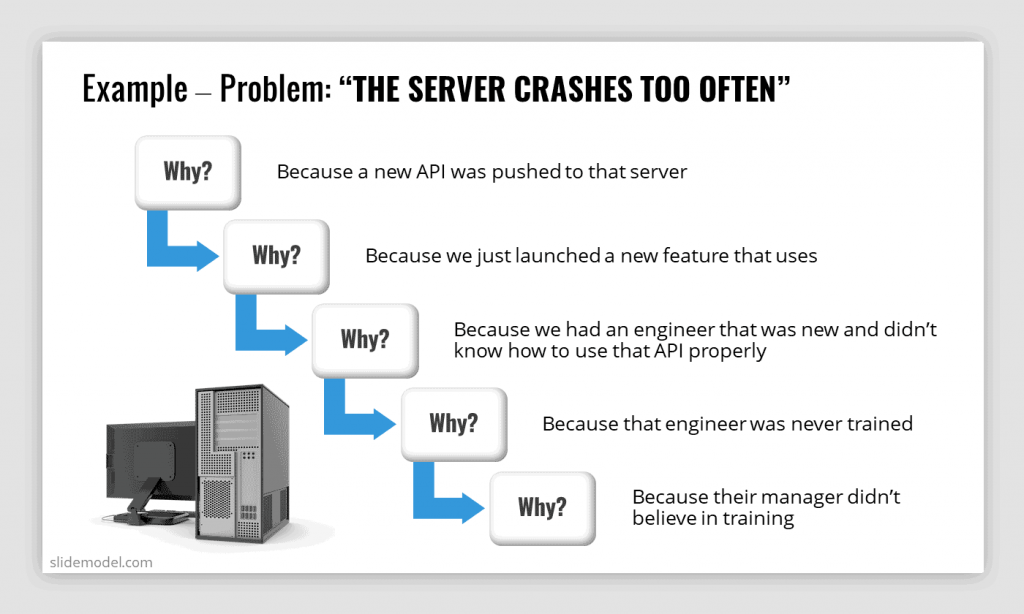
When looking to find the root cause of a problem, the 5 Whys technique can be a simple alternative to SCAMPER. The technique involves asking five questions to identify the problem. You can learn more about this technique from our article about using the 5 whys root cause analysis.
TRIZ
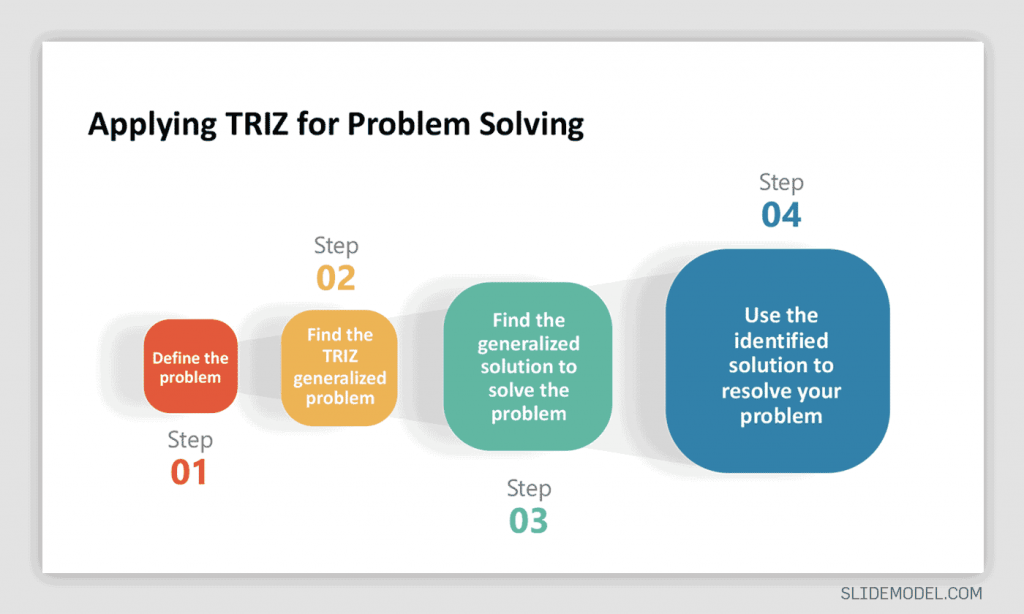
TRIZ is known as the theory of inventive problem-solving. The technique offers 40 principles and 76 standards to help you place the problem conveniently in a box to find a solution. You can see our guide on TRIZ to learn how to use this technique.
Heuristics
Heuristics are problem-solving tools for resolving challenging problems. We discussed heuristics in detail in a previous article. There are a number of formal and informal models that can be used for this purpose including fast-and-frugal tree, recognition heuristic, fluency heuristic, gaze heuristic, etc.
Mind Mapping
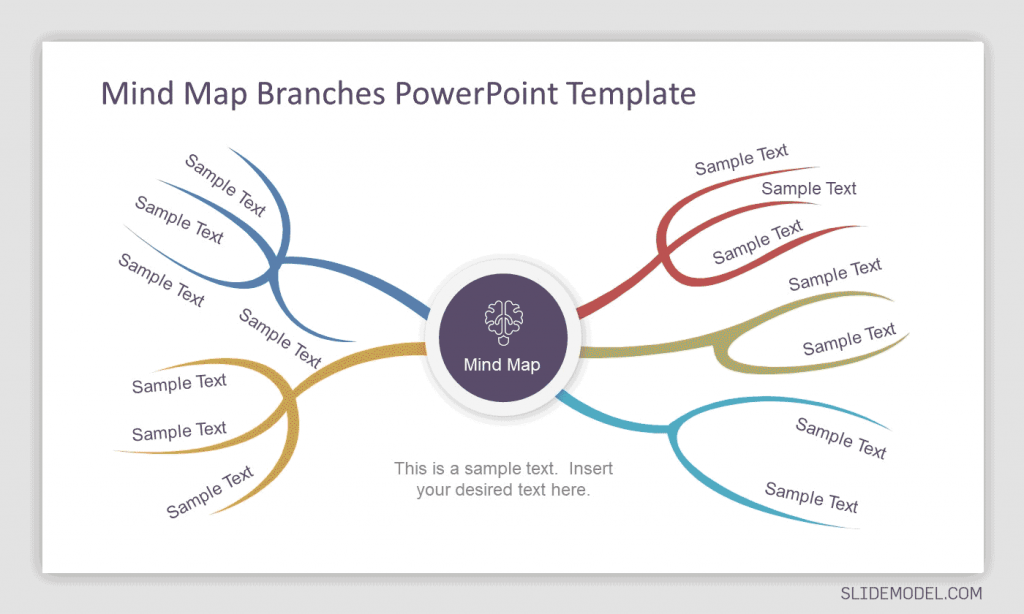
Mind mapping is a well-known technique to create connections associated with clusters around a central idea. Mind mapping can be used for organizing ideas, brainstorming, presenting ideas visually, etc. You can see our article to learn about the use of mind mapping in presentations or download mind map templates & slides here.
Decision Trees
In a previous article, we discussed the use of decision trees for improving decision-making. A decision tree is a visual representation of different factors to aid decision-making. The visualization of variables can help create a map to define the key factors affecting a decision using a decision tree to find the best possible outcome for achieving desired results.
Final Words
The SCAMPER technique provides a step-by-step process for finding solutions, aiding learning, and scamper brainstorming ideas. Gathering ideas using SCAMPER might be easier than presenting them. Therefore, the process of gathering ideas should be followed up with organizing them. Be it with a follow-up session with the same team or by an individual tasked with making the gathered ideas more cohesive. These ideas can then be presented in the form of results and analysis that can be summarized for decision making, gathering knowledge about a certain topic, and problem-solving.
